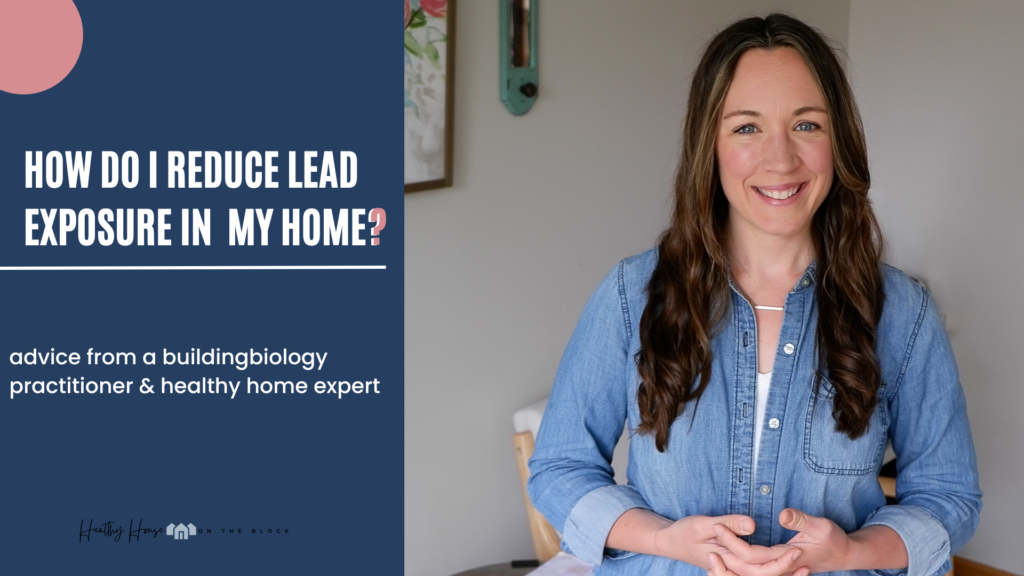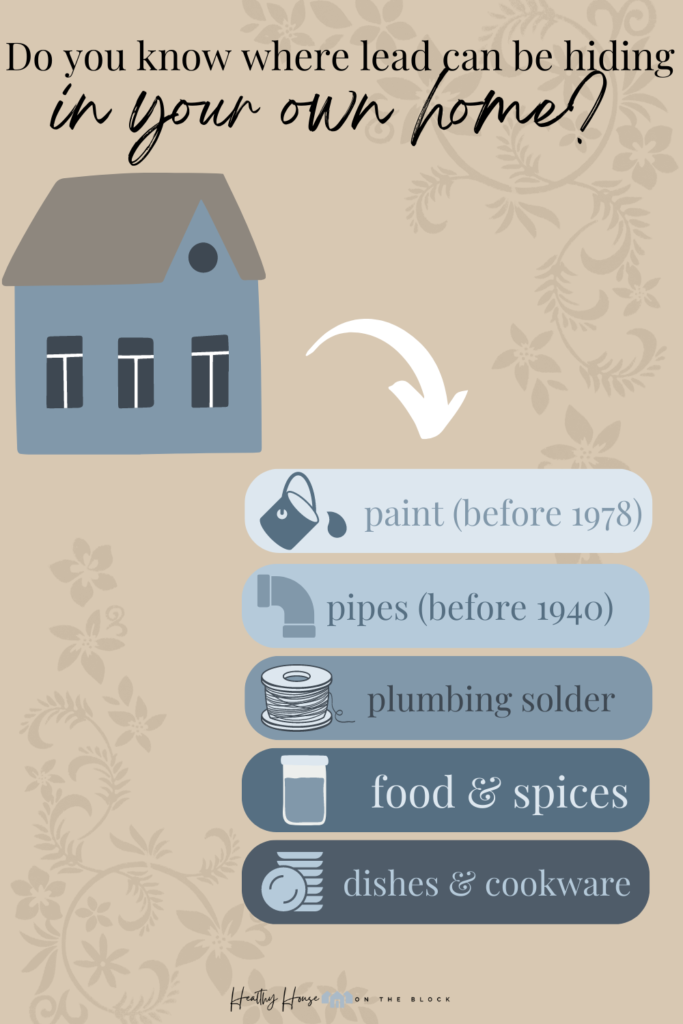
Not all toxins that we have in our home are man made chemicals or toxins. In fact, many toxins in our homes are natural elements in nature or in the earth. Lead toxins are one form of toxins that have been around since the beginning of time. Lead is a natural element in the earth and in our soil, and has been used for centuries in our metal production.
And while lead toxins have been studied over time, it wasn’t until 1979 when a pediatrician and child psychiatrist began documenting the dangers of lead exposure even at low levels to children.
From there we’ve gained insight and learned more and more through studies and research that has been published. And what we’ve learned is that really no level of lead toxins in our body is safe. Lead can quickly be distributed to our organs, brain and bones once it enters our body.
And even after knowing all this, there are still trace amounts of lead toxins allowed in many of our building materials and home items in the US and around the world. Do you know what items in your home can potentially contain lead toxins?

LEAD TOXINS & YOUR HEALTH
The most important thing to know about lead toxins is that our bodies do not detoxify this material very well at all. Essentially, lead toxins can stay in the bloodstream for a very long time.
So if you were exposed in small amounts to lead toxins every single day, the level of lead in your bloodstream would increase every single day as your body just can’t get rid of this toxin fast enough.
There is no system of the body that is not affected by lead toxicity. The central nervous system and the gut are the two biggest areas that see the worst symptoms due to lead exposure. This can range from
- Concentration issues
- Depression
- Nausea
- Abdominal pain
- Fatigue
- Problems with Sleep
- Headaches
- Anemia
Lead exposure has also been shown to damage the cell membranes of red blood cells and cells of the immune system, which decreases immune activity.
And the most important thing to know is that children often have the worst symptoms as their bodies are much smaller in comparison to the amount of lead it takes to start building up within their systems. And due to the fact that kids are in a constant state of growth and development, the absorption of lead can occur more quickly than in adults. Let’s also not forget that children are more prone to ingest and inhale dust that may contain lead just due to their habits.
Lead has a half life of about 40 days in humans, however it’s even higher in children as their bones are developing and this can allow lead to be reintroduced to the bloodstream over and over again.
Lead in children can cause delays in development, changes in their mood and demeanor as well as all the issues that adults see.

WHERE IS LEAD IN YOUR HOME?
While many of us have been told that lead is not in newer homes, the truth is that YES, lead is still used today. However, it is used in different materials and in different applications, not all of which are harmful to humans.
Paint (before 1978): Paint that is in older homes, often built before 1978, can contain lead toxins. While this paint is often covered up with multiple layers of additional paint that DON’T contain lead, it’s still important to know a few things. Paint that is flaking or cracking can become problematic as the fine particles can mix with your air and dust, meaning you become exposed to the lead. And if you’re EVER going to do any sort of remodel work it’s a good idea to contact a contractor who is certified to deal with lead in safe ways.
Pipes (before 1940): The easy way to tell if you have lead pipes is by simply looking at them. First, lead pipes are often a dull gray color. If you were to take a sharp object, such as a key and scratch the pipe, you would see a shiny silver line left by the object. Often lead pipes were just used in drain pipes, and so technically there is little concern for your health. Lead drum traps are another thing you may see in an older home. If these pipes start to deteriorate, it’s a good idea to replace them with ABS or PVC, but until then, leave them undisturbed.
Solder (mostly before 1986): If you have copper pipes in your home, they are most likely soldered together with, well, solder. Older solder (and even some new imported solder), can contain lead toxins, which could then leach into your water supply. Copper piping is often lines that run directly to your fixtures and faucets, meaning this is an area for concern. Make sure you use a point of use filter if you do have copper pipes that were installed prior to 1986.
Food & Spices: Soil often contains large amounts of lead. This means that any vegetable that grows either in the ground or close to the ground has potential for lead toxins to be on the produce itself.
Some food and spices that are imported also could contain trace amounts of lead. It is most common in imported candy, and imported spices such as:
- Curry
- Anise
- Coriander
- Turmeric
- Cloves
- Chili powder
Dishes: Some ceramics can contain lead in the glaze and in the interior of the material. Clays often naturally have amounts of lead depending on where it is sourced from. Ceramics imported from other countries or older China or enameled cast iron has the potential for lead to be in the glaze. After the 1970s, there were stricter rules in the US around dishware, but beware that imported items to this day can still contain lead toxins.

REDUCING LEAD EXPOSURE RIGHT NOW
There are some things that you can do right away to reduce lead exposure in your home that will likely make a large impact on your space and your health.
Hand Washing Habits: One of the most important habits to reduce lead exposure, especially with children is to wash hands before eating or touching food. Lead is not actually absorbed through the skin, but instead, it is ingested or fine particles can be inhaled. By washing your hands or your kids hands before meals, you can prevent exposure from anything that may have been touched.
Get Rid of Dust: If you live in an older home especially, be diligent about reducing dust wherever you can in your home. Lead from soil outside or materials inside can end up in the dust in your home. And the truth is, all of us ingest some dust, which can lead to lead exposure. Kids ingest the most dust, but by reducing the amount of dust around the house in general, it’s another way to avoid potential exposure.
Filter Your Water: While I think that a water filter is a good idea in ANY home, it is certainly a good idea in a home built prior to 1986, when lead solder was used. Lead can leach into your water from this solder connecting copper pipes. And so a point of use filter with the NSF certification is the best way to reduce lead in your water.
Throw Away or Replace Certain Items: Especially in the kitchen, if you notice ceramic dishes or cookware that has scratches, you’ll want to replace them sooner than later. Other things like doorknobs with worn off finishes that could potentially expose lead are something you want to replace as well.
Avoid Imported Candy & Spices: Stick to spices and candy that has been grown and made right here in the USA. Other countries don’t have the regulations and standards that the US does when it comes to trace amounts of lead in foods. You can often look at packaging to see where the food is imported from.
Wash Fruits & Veggies: Fruits and veggies should be washed or soaked in a vinegar solution before consuming them. This will ensure that the dust and the soil that could obtain trace amounts of lead is washed down the drain. Washing fruits and veggies off right away before placing them in your fridge is another way to avoid potential exposure to lead toxins.
AVOID LEAD TOXINS IN THE FUTURE
And as you move forward and know more about lead, here are some of the areas you can check for lead before you purchase:
Tile: A few weeks ago I published a post about tile and the potential toxins in tile around your home. Some tile being sold currently contains lead in the interior of the material. This means it wouldn’t likely be problematic unless you were to find a scratch or raw edge, exposing the interior. Fireclay tile and NSF Certified tile are great options to reduce lead exposure.
Doorknobs & Cabinet Hardware: Door Knobs and cabinet hardware that are made of brass often contain a percentage of lead in the metal. However, a brass door knob or hardware that is coated with an enamel, wouldn’t expose you to any lead. That being said if the enamel coating were to wear away, exposing the brass underneath, there could be potential lead exposure happening. A solid metal like steel is a great way to go if possible.
Faucets: In case you missed last week’s blog post all about lead free faucets, it’s worth a read. Faucets are allowed to contain trace amounts of lead, even in the United States. Look for faucets that advertise 100% lead free rather than just “lead free” and remember the material of the waterway in a faucet should be made of stainless steel.
Cookware & Dishes: Be VERY smart about your cookware and dishes. Opt for something that has a lead free glaze and is made in the USA. Do research before you purchase, and try to avoid a vintage set if possible, as there’s more potential lead exposure from those than new dishes and cookware purchased.

Lead isn’t a toxin we need to be scared of and it’s not a toxin we need to be fixated on. However, if there’s any place in your home where you can reduce exposure, it’s worth your health and wellness to do so.
Share this:
- Click to share on Facebook (Opens in new window) Facebook
- Click to share on LinkedIn (Opens in new window) LinkedIn
- Click to share on Reddit (Opens in new window) Reddit
- Click to share on Pinterest (Opens in new window) Pinterest
- Click to print (Opens in new window) Print
- Click to share on X (Opens in new window) X





Pingback: Healthy House Hunting | Focus On Health & Wellness In Your New Space - Healthy House on the Block
Pingback: Ceramic Cookware: Everything You Need to Know - Healthy House on the Block